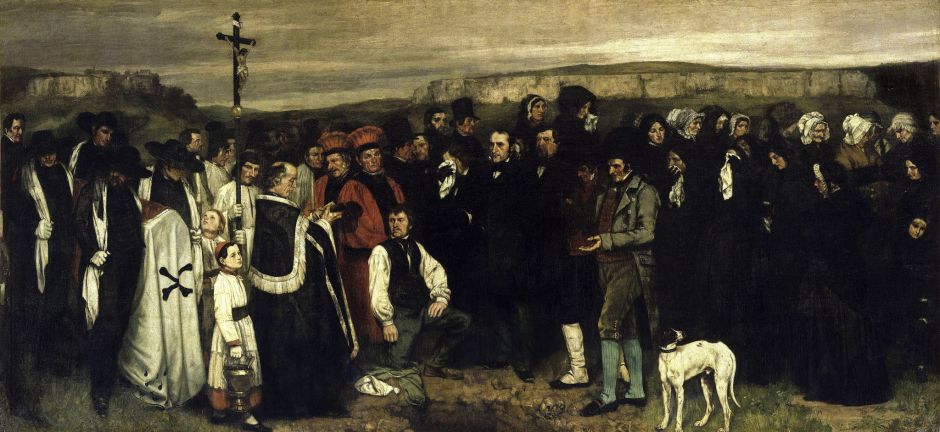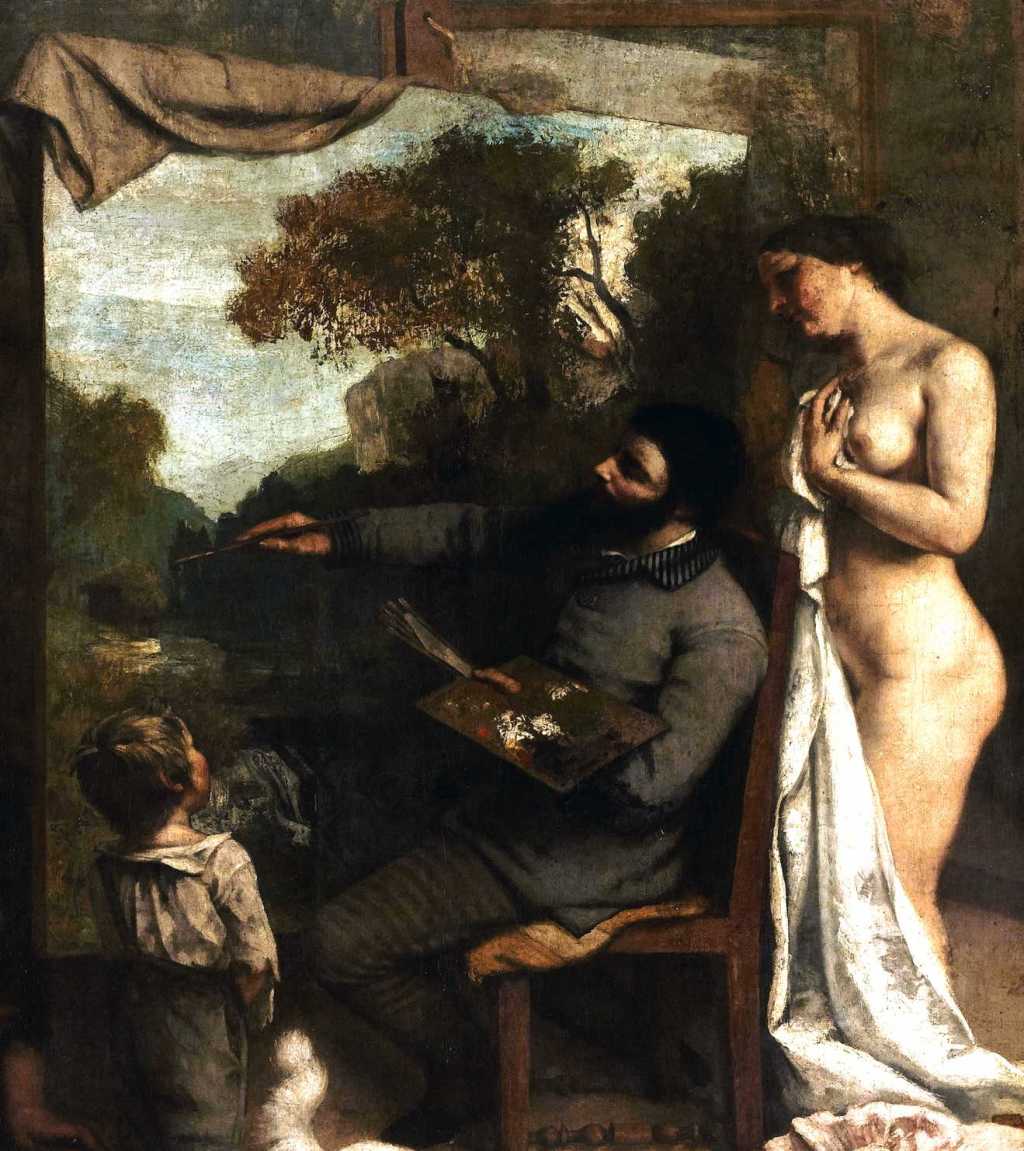Two hundred years ago today, Gustave Courbet was born in the country town of Ornans in Doubs, in the north-east of France. His paintings were of great influence in the development of art throughout Europe and North America. In my recent series of six articles examining his career and paintings (listed at the end), I have shown most of his major works. In this article, I look at his dozen most important paintings and their lasting influence.

Young painters are apt to produce exaggerated self-portraits, and Courbet’s The Desperate Man, from about 1843, is no exception. Here he grimaces wildly at his own canvas, and signs off in bright red, bringing it close to being his early manifesto.

Although tragically destroyed during the Allied bombing of the German city of Dresden during the Second World War, Courbet’s The Stone Breakers from 1849 marks the dawn of social realism and Naturalism. Courbet later explained that he encountered this group of men on the roadside one day, apparently when he was at home in Ornans. He felt they were so complete an expression of poverty that he was immediately inspired to paint them, and invited them to attend his studio the following morning.

Before he had even completed that, Courbet was at work on his monumental A Burial at Ornans (1849-50), which was shown at the Salon of 1850 (as was The Stone Breakers), established his reputation, and became one of the canonical works of European art. This huge painting depicts in remarkably unemotional and objective terms the funeral of the artist’s great uncle in the small provincial town of Ornans. Such a large canvas showing what would previously have been considered a minor genre motif demanded revision of what was accepted as history painting.

Courbet continued to paint founding works of his new realism in The Wheat Sifters (1854). This prepared the way for Jean-François Millet, later Léon-Augustin Lhermitte, and culminated in dominance at the Salon of Naturalism, led by Jules Bastien-Lepage in the early 1880s.

In the mid-1850s, he turned his attention more to landscapes, including that of Château d’Ornans from 1855. The town seen in the valley in the middle distance is Ornans, straddling the River Loue, and the Château is the hamlet at the left, poised above the valley.

Then followed another huge and enigmatic canvas which remains the subject of speculation: his Painter’s Studio from 1855. The figures in this allegory show individuals who had influence over Courbet’s life and artistic career. At the right are the artist’s friends and admirers, including his first patron Alfred Bruyas, critics Champfleury and Baudelaire who had been so positive in their reactions to his work, and others. At the left a man with dogs has been interpreted as an allegory of the Emperor Napoleon III. Behind him are figures who were long assumed to be allegorical, but have been identified as contemporary people, most of whom had been supporters of the Emperor’s regime.
For the Exposition Universelle to be held in Paris in 1855, he submitted a total of fourteen works, including A Burial at Ornans and The Painter’s Studio. The latter two, being very large, were rejected (along with another), so Courbet withdrew from the exhibition and set up his own gallery of paintings next door to the Exposition – in anticipation of the Salon des Refusés to be held in 1863.

For the Salon of 1857, Courbet prepared six paintings, of which the most notorious is his Young Ladies Beside the Seine (1856), which shows a pair of prostitutes relaxing under a tree, a theme to be revisited by Édouard Manet in Le déjeuner sur l’herbe in 1863, and subsequently by the Impressionists. Like Manet’s successor, Courbet’s painting was rejected by the Salon jury.

Later in the 1860s, and largely to satisfy commissions from wealthy collectors of erotica, Courbet broke taboos in his paintings of nudes, such as The Sleepers from 1866, for which Joanna Hiffernan modelled. When exhibited by a picture dealer in 1872, its explicit lesbian motif resulted in a police report and the painting being removed from public view for more than a century.

While satisfying those carnal desires, Courbet turned to more mysterious landscape paintings in a quest for the “sources” of rivers. His views ascended to the headwaters, eventually ending in the “source”, caves from which stygian waters emerge into the world, as in The Grotto of Sarrazine near Nans-sous-Sainte-Anne (c 1864). Here he explores the making of marks, often using a palette knife, an avant garde technique.

Another of Courbet’s favourite themes which was to become strong among the Impressionists was the snowscape, using very loose brushstrokes, as in his Effect of Snow from 1866-8. This should perhaps be seen alongside some of the wintry views of roads painted by Camille Pissarro during the following decade.

Just before the Franco-Prussian War, Courbet developed the motif of the breaking wave in a coastal landscape consisting almost entirely of sky and sea. This coincided with the popularity of Hokusai’s woodblock print, and was taken up by Albert Bierstadt and even the academic artist William-Adolphe Bouguereau.
Tragedy struck Courbet in 1871, as a result of his involvement in the Paris Commune, and its demolition of the Vendôme Column. Not content with him serving a prison sentence and paying a hefty fine, he was later driven into exile by a government demand for over 300,000 Francs in restitution.

During his exile in Switzerland, Courbet painted some of the finest landscapes of his career, such as Sunset over Lac Leman from 1874, the year of the First Impressionist Exhibition in Paris. But instead of his art continuing to drive the revolution that was taking place in painting there, the Republican French government hounded him into exile, alcoholism, and an early death from liver disease on 31 December 1877. I wonder what could have happened had Gustave Courbet become involved with Impressionism during the 1870s.
Some governments have neither regard for art or culture nor for the achievements of their own citizens.
Detailed articles here about Gustave Courbet
1: The Desperate Man
2: The group
3: Allegory
4: The erotic
5: Waves and caves
6: Into exile

